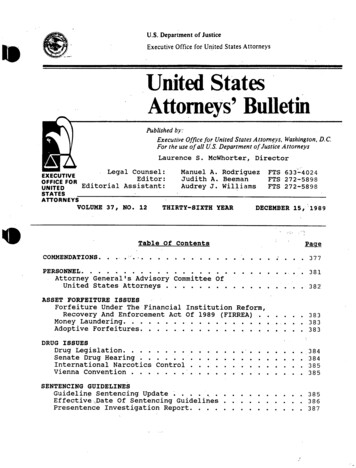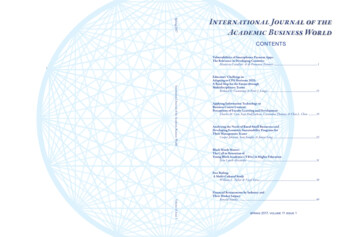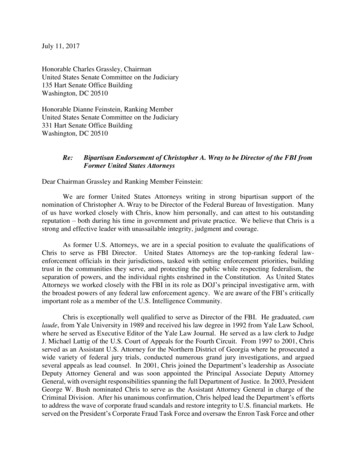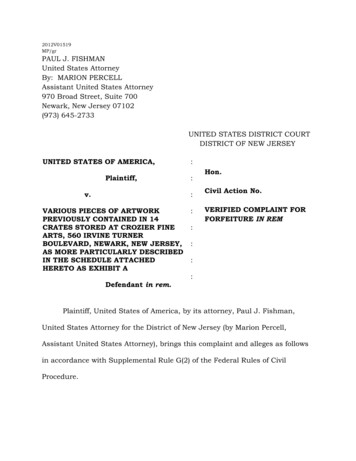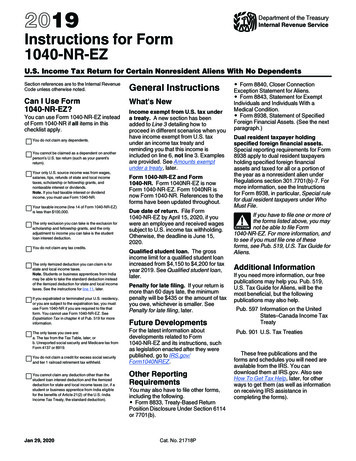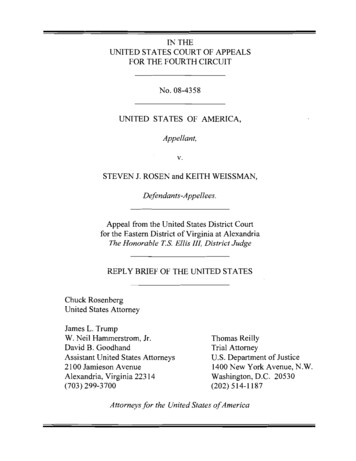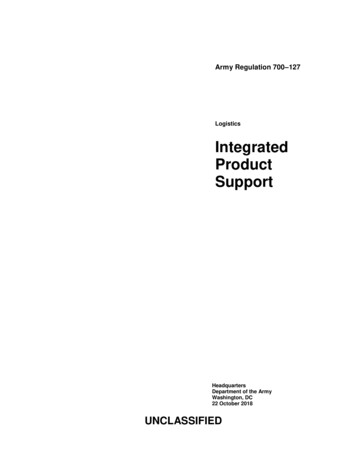
Transcription
Army Regulation tersDepartment of the ArmyWashington, DC22 October 2018UNCLASSIFIED
SUMMARY of CHANGEAR 700– 127Integrated Product SupportThis mandated revision, dated 22 October 2018—oIncorporates Army Directive 2017– 31, Acquisition Reform Initiative #5: Aligning Sustainment Policy to Foster CostEfficiency and Improved Readiness, dated 5 March 2018 (paras 4–1a, 4–1h(2), 4–16a, 6–5f, 6–5g, 6–10c, 7 – 1, 7 –2,8–2f(3), 8–2f(4), 12– 5, 12 –8, and glossary, section II).
HeadquartersDepartment of the ArmyWashington, DC22 October 2018*Army Regulation 700–127Effective 22 October 2018LogisticsIntegrated Product SupportHistory. This publication is a mandatedrevision. The portions affected by this mandated revision are listed in the summary ofchange.Summary. This policy implements keyprovisions of Army Directive 2017 – 31.Applicability. This regulation appliesto the Regular Army, the Army NationalGuard/Army National Guard of the UnitedStates, and the U.S. Army Reserve, unlessotherwise stated. Also, it applies to materieldevelopers, capability developers, and organizations involved in materiel and software acquisition within the Regular Army,the Army National Guard/Army NationalGuard of the United States, and the U.S.Army Reserve. This regulation is applicable during full mobilization, unless otherwise stated.Proponent and exception authority.The proponent of this regulation is the Assistant Secretary of the Army (Acquisition,Logistics and Technology). The proponenthas the authority to approve exceptions orwaivers to this regulation that are consistentwith controlling law and regulations. Theproponent may delegate this approval authority, in writing, to a division chief withinthe proponent agency or its direct reportingunit or field operating agency, in the gradeof colonel or the civilian equivalent. Activities may request a waiver to this regulationby providing justification that includes afull analysis of the expected benefits andmust include formal review by the activity’s senior legal officer. All waiver requests will be endorsed by the commanderor senior leader of the requesting activityand forwarded through their higher headquarters to the policy proponent. Refer toAR 25 – 30 for specific guidance.and Technology) (SAAL– ZL), 103 ArmyPentagon, Washington, DC 20310 – 0103.Suggested improvements. Users areinvited to send comments and suggestedimprovements on DA Form 2028 (Recommended Changes to Publications and BlankForms) directly to the Assistant Secretaryof the Army (Acquisition, Logistics andTechnology) (DASA– APL), 103 ArmyPentagon, Washington, DC 20310 – 0103.Army internal control process. Thisregulation contains internal control provisions in accordance with AR 11 –2 andidentifies key internal controls that must beevaluated (see appendix B).Committee management. AR 15 – 1requires the proponent to justify establishing/continuing committee(s), coordinatedraft publications, and coordinate changesin committee status with the U.S. Army Resources and Programs Agency, Departmentof the Army Committee Management Office (AARP – ZA), 9301 Chapek Road,Building 1458, Fort Belvoir, VA22060– 5527. Further, if it is determinedthat an established “group” identifiedwithin this regulation, later takes on thecharacteristics of a committee, as found inthe AR 15 – 1, then the proponent will follow all AR 15 – 1 requirements for establishing and continuing the group as a committee.Supplementation. Supplementationof this regulation and establishment of command and local forms are prohibited without prior approval from the Assistant Secretary of the Army (Acquisition, LogisticsDistribution. This publication is available in electronic media only and is intendedfor the Regular Army, the Army NationalGuard/Army National Guard of the UnitedStates, and the U.S. Army Reserve.Contents (Listed by paragraph and page number)Chapter 1General, page 1Section IIntroduction, page 1Purpose 1 – 1, page 1References and forms 1– 2, page 1Explanation of abbreviations and terms 1– 3, page 1Responsibilities 1 – 4, page 1Section IIResponsibilities, page 1*This publication supersedes AR 700-127, dated 11 October 2016.AR 700–127 22 October 2018UNCLASSIFIEDi
Assistant Secretary of the Army (Acquisition, Logistics and Technology) 1 – 5, page 1Assistant Secretary of the Army (Financial Management and Comptroller) 1– 6, page 2Assistant Secretary of the Army (Installations, Energy and Environment) 1 – 7, page 2Assistant Chief of Staff for Installation Management 1 – 8, page 2Deputy Chief of Staff, G– 1 1 – 9, page 2Deputy Chief of Staff, G– 3/5/7 1 – 10, page 2Deputy Chief of Staff, G– 4 1 – 11, page 3The Chief Information Officer/G– 6 1 – 12, page 3Deputy Chief of Staff, G– 8 1 – 13, page 3The Surgeon General 1 – 14, page 3Chief of Engineers 1 – 15, page 3Program executive officers 1 – 16, page 4Capability developers 1 – 17, page 4Materiel developers 1 – 18, page 5Materiel commands 1– 19, page 5Commander, U.S. Army Test and Evaluation Command 1 – 20, page 6Trainer/training developers 1 – 21, page 7Commanders, Army commands, Army National Guard, U.S. Army Reserve, Army service component commands, anddirect reporting units 1– 22, page 7Chapter 2Framework, page 7Integrated product support 2 – 1, page 7Integrated product support elements 2 – 2, page 7Integrated product support process 2– 3, page 8Integrated product support process in the acquisition strategy 2 – 4, page 8Chapter 3Integrated Product Support and the Defense Acquisition Framework, page 8Overview 3– 1, page 8Integrated Product Support development 3 – 2, page 8Pre-materiel acquisition 3 – 3, page 9Materiel Solutions and Analysis Phase 3 – 4, page 9Technology Maturation and Risk Reduction Phase 3– 5, page 10Engineering and Manufacturing Development Phase 3 – 6, page 10Production and Deployment Phase 3 – 7, page 10Operations and Support Phase 3– 8, page 11Chapter 4Product Support Management, page 11Section IStrategic Approach and Risk Management, page 11Performance based product support strategies 4 – 1, page 11Legacy materiel 4 – 2, page 12Supportability risk management 4– 3, page 12Section IIOrganization, page 12Product support manager 4 – 4, page 12Product support integrator 4 – 5, page 14Product support provider 4 – 6, page 14Product support management integrated product team 4 – 7, page 15Army integrated product support executive committee 4 – 8, page 15Section IIIIntegrated Product Support Management of Joint Programs, page 16iiAR 700–127 22 October 2018
Joint programs and Joint logistics 4 – 9, page 16Lead Service product support managers 4 – 10, page 16Section IVImplementing Performance Based Product Support Strategies, page 16Metrics 4– 11, page 16Performance-based arrangements 4 – 12, page 16Section VContract Performance-Based Arrangements, page 17Requirements 4 – 13, page 17Public-private partnerships 4 – 14, page 17Contractor logistics support (nonpublic-private partnership support) 4 – 15, page 17Contract management 4 – 16, page 18Planning 4 – 17, page 18Reprocurement 4 – 18, page 19Chapter 5Design, page 19Design interface 5 – 1, page 19Design for energy efficiency 5 – 2, page 19Maintenance task design parameters 5 – 3, page 19Condition-based maintenance plus in the design 5 – 4, page 19Design for manpower and personnel integration 5 – 5, page 20Design for standardization and interoperability 5 – 6, page 20Design for environment, safety, and occupational health 5 – 7, page 20Design for corrosion resistance 5 – 8, page 20Supply Management Army-Operations and Support Cost Reduction Program 5 – 9, page 20Commercial and nondevelopmental items market investigation 5– 10, page 20Chapter 6Integrated Product Support Analysis and Software Tools, page 21Requirement 6– 1, page 21Product support analysis and logistics product data 6– 2, page 21Analysis of product support alternatives 6 – 3, page 21Life cycle cost analysis 6 – 4, page 22Reliability centered maintenance analyses, failure mode, effects, and criticality analysis, and fault tree analysis 6 – 5, page 22Level of repair analysis 6– 6, page 22Modeling and simulation 6 – 7, page 23Core logistics determination of applicability and core logistics analysis 6 – 8, page 23Core depot assessment 6 – 9, page 23Depot source of repair analysis 6 – 10, page 23Provisioning analysis 6 – 11, page 24Post-fielding support analysis 6 – 12, page 24Integrated Product Support software tools 6 – 13, page 24Chapter 7Intellectual Property, Data Management, and Configuration Management, page 24Intellectual property strategy 7 – 1, page 24Data Management 7 – 2, page 25Configuration management 7 – 3, page 25Logistics product data 7 – 4, page 25Provisioning technical documentation 7 – 5, page 25Equipment publications 7 – 6, page 26Maintenance allocation chart 7 – 7, page 26AR 700–127 22 October 2018iii
Operator manuals 7 – 8, page 26Maintenance manuals 7 – 9, page 26Repair parts and special tools list 7 – 10, page 26Depot maintenance work requirements and national maintenance work requirements 7 – 11, page 26Chapter 8Integrated Product Support Planning, page 26Integrated product support planning considerations 8 – 1, page 26Life Cycle Sustainment Plan 8 – 2, page 27Life Cycle Sustainment Plan content 8 – 3, page 28Maintenance support planning 8– 4, page 28Logistics footprint 8– 5, page 29Special Tools 8 – 6, page 29Provisioning plan 8 – 7, page 30Depot maintenance partnerships 8 – 8, page 30Recapitalization program 8– 9, page 30Depot Maintenance Support Plan 8 – 10, page 30Software support planning 8 – 11, page 30Fielded software support 8 – 12, page 30Computer Resources Life Cycle Management Plan 8– 13, page 30Resource planning 8 – 14, page 30Operating and support cost 8 – 15, page 31Affordability 8 – 16, page 31Cost as an independent variable (cost consciousness) 8 – 17, page 31Program cost estimate 8– 18, page 31Funding appropriations 8– 19, page 31Replaced System Sustainment Plan 8 – 20, page 31System Demilitarization and Disposal Plan 8 – 21, page 32Materiel fielding planning 8 – 22, page 32Post-production support planning 8 – 23, page 32Preservation and storage of tooling for Major Defense Acquisition Programs 8 – 24, page 32Chapter 9Force Development Documentation and Training Systems, page 32Section IEquipment and Personnel, page 32Force development documentation 9– 1, page 32Line item numbers 9 – 2, page 33Basis of issue plan feeder data 9 – 3, page 33Basis of issue plan 9 – 4, page 33Manpower requirements criteria 9– 5, page 34Major item system map 9 – 6, page 34Section IITraining Systems and Devices, page 34Pre-acquisition 9 – 7, page 34Acquisition 9 – 8, page 34Training system and training device fielding 9 – 9, page 34Training system and training device support 9 – 10, page 34Post-production software support 9 – 11, page 34New equipment training 9 – 12, page 34Chapter 10Environment, Safety, and Occupational Health, page 35Environmental impact 10 – 1, page 35ivAR 700–127 22 October 2018
Environment, safety, and occupational health considerations 10 – 2, page 35Hazardous materials 10– 3, page 35Chapter 11Test and Evaluation, page 36Supportability test and evaluation 11 – 1, page 36Product support package 11 – 2, page 36Logistics demonstration 11– 3, page 36Chapter 12Integrated Product Support Program Reviews and Reporting, page 37Milestone Decision Review 12– 1, page 37Type Classification 12 – 2, page 38Materiel Release 12 – 3, page 38Supportability Assessment 12 – 4, page 38Independent Logistics Assessment 12– 5, page 38Department of the Army Integrated Product Support Reviews 12 – 6, page 38Sustainment reviews 12 – 7, page 38Other Army reviews 12 – 8, page 39Integrated Product Support reporting 12 – 9, page 39AppendixesA. References, page 40B. Internal Control Evaluation for the Integrated Product Support Program, page 43Table ListTable 8– 1: Life Cycle Sustainment Plan mandatory annexes, page 27Table 8 – 2: Life Cycle Sustainment Plan Development, Coordination, and Approval Process, page 28GlossaryAR 700–127 22 October 2018v
Chapter 1GeneralSection IIntroduction1– 1. PurposeThis regulation prescribes the Department of the Army (DA) policy for implementing performance-based life cycle productsupport, including performance-based logistics, through the Army’s Integrated Product Support (IPS) Program. The IPSProgram includes planning, developing, acquiring, and sustaining well-defined, affordable performance-based productsupport strategies (PBPSSs) that meet the Soldier’s requirements for Army materiel and software throughout their lifecycle. Additional guidance for implementing this policy is provided in Department of the Army Pamphlet (DA Pam)700 – 127 and must be used in conjunction with this regulation. The policy implements PBPSS requirements; defines theprocess that the materiel developer (MATDEV) will use to develop and integrate a PBPSS with the systems engineeringprocess; identifies the framework (twelve integrated IPS elements) that will be used to develop the PBPSS; assigns responsibilities for developing and implementing PBPSSs for Army materiel and software; and requires MATDEVs to implement metrics to measure product support performance. DA Pam 700 – 127 provides implementing guidance for thisregulation. This policy does not apply to business information technology systems developed and supported under theBusiness Capability Lifecycle or associated processes.1– 2. ReferencesSee appendix A.1– 3. Explanation of abbreviations and termsSee the glossary.1– 4. ResponsibilitiesResponsibilities are listed in section II of chapter 1.Section IIResponsibilities1– 5. Assistant Secretary of the Army (Acquisition, Logistics and Technology)The ASA (ALT) will—a. Develop IPS policy.b. Oversee the development and execution of IPS.c. Approve product support strategies and plans for Army Acquisition Category (ACAT) I programs and ACAT IIprograms where the Army Acquisition Executive (AAE) is the milestone decision authority (MDA).d. Ensure certification of Major Defense Acquisition Programs (MDAPs) related to sustainment planning in accordancewith requirements in the following:(1) Section 2366a, Title 10, United States Code (10 USC 2366a) and 10 USC 2366b.e. Assign responsibilities to the Deputy Assistant Secretary of the Army (Acquisition Policy and Logistics (DASA(APL)) who will—(1) Establish policy for the Life Cycle Sustainment Plan (LCSP) and Independent Logistics Assessment (ILA).(2) Where the AAE is the MDA, approve LCSPs, ILAs, Computer Resources Life Cycle Management Plan (CRLCMP),and interim contractor support (ICS) to Objective Support Concept Transition Plan.(3) Ensure IPS requirements are validated and included in the materiel and software acquisition process to support fullmateriel release of programs, materiel, and software.(4) Provide a supportability position on materiel release of ACAT I through III materiel and software.(5) Serve as the Army Life Cycle Logistician for new, modified, upgraded, and displaced materiel and software, exceptfor supply class VIII; medical materiel and software. As the Army Life Cycle Logistician, the DASA (APL) will—(a) Establish internal procedures and techniques to assess supportability management and execution for assigned acquisition programs.AR 700–127 22 October 20181
(b) Review capability requirement documents (CRDs), IPS related program management documentation, test plans,and contract and solicitation documents to ensure IPS considerations are appropriately addressed.(c) Assist MATDEVs in developing IPS strategies and plans.(d) Participate in integrated product teams (IPT) to include the Overarching Integrated Product Team (OIPT), ProductSupport Management IPT (PSMIPT), Test and Evaluation (T&E) Working IPT (WIPT), and sustainment review (SR)activities.(e) Inform the MATDEV, capability developer (CAPDEV), materiel command, and other program participants of supportability planning deficiencies. Unresolved issues will be elevated to the OIPT.(f) Oversee supportability testing.(g) Participate in milestone (MS) decisions and other program reviews (see Army regulation (AR) 70– 1).(h) Convene and chair IPS reviews for materiel and software approaching a MS decision review.(i) Establish the Headquarters, Department of the Army (HQDA) position concerning the deployability and supportability of all acquisition programs.(j) Review the Army manpower and personnel integration (MANPRINT) effort, in coordination with other Army staffagencies, to ensure effective implementation in accordance with HQDA and Department of Defense (DOD) requirements.(k) Serve as the HQDA proponent and chair for the Army Integrated Product Support Executive Committee (AIPSEC).(l) Serve as the HQDA functional chief and representative for the life cycle logistics career field of the Army Acquisition Corps and workforce.(m) Serve as the HQDA proponent for the product supportability analysis (PSA) process and the resulting logisticsproduct data (LPD).(n) Establish and manage the Life Cycle Logistics Achievement of the Year Awards Program.(o) Serve as the Army point of contact for the Department of Defense Product Support Manager (PSM) of the YearAward, and the Secretary of Defense Performance-based Logistics Awards Program.1– 6. Assistant Secretary of the Army (Financial Management and Comptroller)The ASA (FM&C) will—a. Review program and budget requests supporting life cycle contractor support (LCCS).b. Integrate materiel into working capital funds, as appropriate.c. Provide concurrence and/or feedback to DASA (APL) policy concerning economic analysis.1– 7. Assistant Secretary of the Army (Installations, Energy and Environment)The ASA (IE&E) will ensure that environmental considerations, including environmental compliance, hazardous materialuse, and environmental sustainability are incorporated into PSAs.1– 8. Assistant Chief of Staff for Installation ManagementThe ACSIM will—a. Participate in the IPS process for environmental and facility implications.b. Coordinate with MATDEVs to perform the necessary analysis, advance planning and programming for facility support for new, modified, upgraded, or displaced materiel and software commencing at pre-MS C.c. Program for new or modified facilities at the gaining installations needed to meet the facility requirements identifiedin the LCSP by the Chief of Engineers (COE).d. Participate in SRs.1– 9. Deputy Chief of Staff, G –1The DCS, G– 1 will participate in IPS manpower planning and SRs in support of acquisition programs.1– 10. Deputy Chief of Staff, G –3/5/7The DCS, G– 3/5/7 will—a. Ensure initial items of new equipment, including support equipment, are issued to the training base for timely trainingdevelopment, and establishment of functional training documentation and procedures.b. Ensure unit and/or activity modified table of organization and equipment and/or table of distribution and allowancesauthorization documents are updated to enable timely fielding of equipment and supplies.c. Participate in SRs.2AR 700–127 22 October 2018
1– 11. Deputy Chief of Staff, G –4The DCS, G– 4 will—a. Ensure that—(1) The sustainment functions of readiness, supply services, maintenance, transportation, aviation, munitions, securityassistance and related automated logistics systems management are fully integrated and properly support MATDEVsthroughout the program life cycle.(2) The Army integrated logistics architecture (AILA) supports logistics data and logistics domain requirements.(3) The Army bulk condition-based maintenance data (ABCD) interface requirements specification data standard isformalized in the AILA.b. Participate in SRs.1– 12. The Chief Information Officer/G – 6The CIO/G– 6 will—a. Review the Army Enterprise Architecture and Army Enterprise Infrastructure to include logistics domain and logistical data requirements to support the future force capabilities.b. Ensure that logistics data and logistics domain requirements support the AILA.c. Assist in the preparation of the standards viewpoints for integration in the AILA in support of Joint CapabilitiesIntegration Development System (JCIDS) MS requirements.d. Support the ASA (ALT) through the development of policy on the acquisition of information management, information technology, and information resources. Ensure that acquisitions are managed in a manner that implements CIO/G– 6policies and procedures to maximize value while assessing and managing the risks for acquiring information technology.1– 13. Deputy Chief of Staff, G –8The DCS, G– 8 will—a. Ensure adequate resources are planned, programmed and budgeted to execute the Army IPS program.b. Review the funding portion of LCSPs for Army ACAT I programs to ensure alignment with programmed resources.c. Provide analysis for and advise on product support initiatives that reduce the logistics footprint.d. Participate in SRs for ACAT I programs.1– 14. The Surgeon GeneralTSG will—a. Advise and consult with MATDEVs and CAPDEVs on potential health hazards and problems associated with themedical aspects of all materiel acquisition programs.b. Develop the IPS program for medical (class VIII) materiel, including designation of the life cycle logistician inaccordance with AR 40– 60 and AR 40 – 61.c. Participate in SRs.1– 15. Chief of EngineersThe COE will—a. Advise the MATDEV of the cost implications of materiel design and software with respect to facilities requirementsand the impact on the Army’s facilities standardization program.b. Identify facility requirements of the materiel and software for the gaining Army commands (ACOMs), Army servicecomponent commands (ASCCs), and direct reporting units (DRUs), with formal input from the MATDEV, trainer/trainingdeveloper (T/TD) and CAPDEV.c. Coordinate facility and real property requirements with the CAPDEV, MATDEV, ACSIM, gaining ACOM, ASCC,and DRUs, Army Life Cycle Logistician, and T/TD.d. Assist the MATDEV in preparation of facilities related IPS strategies and planning documentation.e. Execute the support facility annex (SFA) process to validate facility and infrastructure requirements and prepareLCSP SFAs for ACAT I materiel. Provide guidance to other CAPDEVs, MATDEVs, T/TDs for developing SFAs forACAT I and II materiel, or provide independent assessment and finding of “No Facility Impacts” based on MS B and MSC outcomes.f. Assist the MATDEV with integrating facilities and infrastructure requirements into the product supportability processand LPD.g. Participate in—(1) AIPSEC.AR 700–127 22 October 20183
(2) PSMIPTs for all facility program requirements and issues.(3) SRs.h. Designate an executive program coordinator to execute paragraphs 1–15a through 1–15f of this regulation and identify, define, validate ACAT I materiel facilities and infrastructure requirements to support the acquisition strategy (AS)and LCSP no later than MS B.1– 16. Program executive officersProgram executive officers (PEOs) are responsible for oversight of the MATDEVs, program portfolios assigned to themby the AAE, and assigning PSMs to all programs in their portfolios. PEOs are responsible for oversight of their PSMs andMATDEVs compliance with this policy.1– 17. Capability developersThe Commander, U.S. Army Training and Doctrine Command (TRADOC) is the Army’s principal CAPDEV. TheCAPDEV for class VIII (medical materiel) is the U.S. Army Medical Department Center and School. Other CAPDEVsinclude U.S. Army Intelligence and Security Command (INSCOM) and U.S. Army Network Enterprise Technology Command/9th Army Signal Command (This command fulfills roles as a CAPDEV and a DRU). CAPDEVs will develop operational and support concepts; doctrine, organization, and force structures; and will determine materiel and software requirements for equipping these force structures. As user representatives, CAPDEVs will ensure that materiel and softwaredevelopmental efforts address user requirements. To ensure that the supportability program fulfills the needs of the user,CAPDEVs will—a. Establish internal policies, procedures, and techniques for implementing this policy.b. Conduct applicable PSAs and tradeoffs as a function of developing CRDs.c. Establish logistics requirements, constraints, materiel design parameters, and system readiness objectives.d. Conduct an analysis of alternatives (AoA) to include alternative operating and materiel and software support conceptswith specific consideration of performance-based options.e. Support the MATDEV in developing the Reliability, Availability, and Maintainability-Cost (RAM– C) RationaleReport.f. Develop specific, measurable, and testable support-related materiel and software requirements or parameters basedon required logistics, operational performance, life cycle cost (LCC) goals, and readiness requirements.g. Assess the impact of the proposed materiel and software on the maintenance capabilities planned for the period inwhich the materiel and software will be introduced.h. Assess the concept and technology of embedded and system health management with regard to its ability to facilitatethe use of embedded diagnostics, instrumentation, prognostics, and similar maintenance enablers, and opportunities forcondition-based maintenance plus (CBM ).i. Identify key performance and related support parameters for inclusion in the CRDs, to include RAM, interoperability,operations and support (O&S) cost, mean down time, manpower, and deployment footprint, that form the basis of theoverall capability of the materiel and software to perform and endure in the required mission operational environment.j. Incorporate materiel and software maintainability, interoperability and supportability considerations into CRDs.k. Document the supportability concept and requirements in the initial capabilities document (ICD), capability development document (CDD), and capabilities production document (CPD).l. Ensure that capabilities describing tactical level logistics are documented in the AILA, and that logistics architecturesubmitted in support of ICD, CDD, and CPD is integrated with the AILA.m. Develop a rough order of magnitude LCC estimate that includes all phases of the acquisition process (through disposal) and document it in the ICD. The LCC estimate will be updated in subsequent CRDs.n. Designate an IPS lead following the materiel development decision (MDD) who will form a CAPDEV chairedPSMIPT that includes representation from the PEO PSM and appropriate IPS acquisition community stakeholders. ThePSMIPT will assist the CAPDEV with IPS analyses, AoA, developing IPS contract requirements, developing the initialLCSP, and other CAPDEV activities. Once a program is initiated and a MATDEV is assigned, the CAPDEV PSMIPT willtransition to become the MATDEV chaired PSMIPT. The CAPDEV PSMIPT will—(1) Participate in pre-MS B activities with the CAPDEV.(2) Participate in the development of the CRDs, and prepare or review all other acquisition program documentation toensure that all IPS considerations are adequately defined.(3) Conduct appropriate PSAs.(4) Support the development of the initial LCSP using the results of the PSA, and ensure that the product supportstrategy is documented in the AS.4AR 700–127 22 October 2018
(5) Provide, through the CAPDEV PSMIPT, the appropriate logistics metrics (to include materiel availability, materielreliability, ownership cost, and mean downtime), criteria, and funding requirements to the MATDEV to incorporate in theacquisition program baseline.(6) Develop supportability testing issues in coordination with the T/TD, tester, evaluator, Army Life Cycle Logistician,and other program participants; and ensure the appropriate logistics considerations and test points are documented in thetest and evaluation master plan (TEMP).o. Following program initiation and assignment of a MATDEV, the CAPDEV will—(1) Participate in the MATDEV PSMIPT.(2) Participate in decision reviews, program reviews, and SRs.(3) Ensure establishment of training programs by the T/TD to develop the skills needed for the operation and supportof newly fielded materiel and software.(4) In coordination with the MATDEV, ensure that user IPS requirements and constraints are identified for inclusionin contract and solicitation documents.(5) Establish support conditions and requirements for initial operational capability (IOC) date in coordination with theMATDEV and gaining ACOM, Army National Guard (ARNG), ASCC, U.S. Army Reserve (USAR), and DRUs.(6) Coordinate with the—(a) MATDEV to develop the support concept that provides the most cost and operationally effective value to the Army.(b) Supporting and gaining commands the necessary procedures to implement the support concept.(7) Provide a representative to support the AIPSEC.(8) Participate in developing performance-based metrics and desired outcomes in the form of key performance parameters (KPPs), key system attributes (KSAs), and additional performance attributes for CRDs, including working with thePSM to develop appropriate product support arrangements and performance-based arrangements (PBAs).1– 18. Materiel developersMATDEVs are responsible for planning and implementing IPS as an integral part of assigned materiel and software acquisition programs. MATDEVs will—a. Ensure that passage of a program from one life cycle phase to the next occurs only when all product support requirements have been satisfactorily accomplished according to this policy and is documented in the LCSP.b. Establish internal procedures and controls to implement this policy.c. In coordination with the PEO, assign a PSM for each ACAT Program at program initiation.d. Participate in SRs.e. Develop the RAM–
Product support management integrated product team 4 - 7, page . 15. Army integrated product support executive committee 4 - 8, page . 15 Section III. Integrated Product Support Management of Joint Programs, page . 16. AR 700-127 22 October 2018: iii




